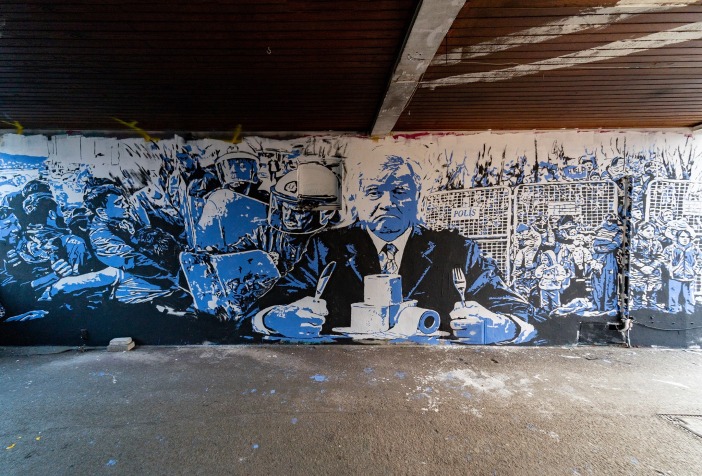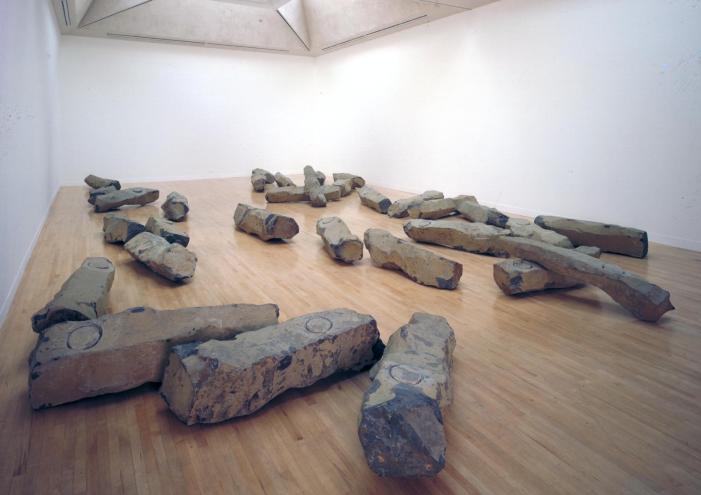Artan Sadiku

The coronavirus epidemics has brought up many social and political issues which, even during the extreme times we are living through now, cannot be simply ignored. They are important because many of them, to a varying degree, determine how we are dealing with this epidemic and how will we live after it fades away. One of the most visible political aspects of this crisis is the re-appearance of the state as the ultimate agency of delivering the response to the coronavirus epidemics.
And from the very beginning I want to make it clear that this is not the appropriate time, for those of us who lean to more anarchic tendencies, to fight the state. Instead we must admit that we need the state now and this should be the last ‘service‘ that we accept from it. Even though we might analyse on how many levels the state response to the epidemic crisis is wrong, we need its service because it must eat its own poisonous soup that it has been cooking for the society. Thus, pushing it to its suicide which, is a call to all of us to organise our own autonomous actions paralleling those of the state. In doing so, we should not limit our collective efforts in only filling the void left by the state but work to find creative and innovative ways of substituting the existing dysfunctional system of services destroyed by the state-market alliance.
We need thus neither downscale neither exaggerate the present epidemic situation, but rather analyse the real material conditions which unfold in the midst of this crisis and build strategies for action without fetishizing or immediately discarding any of the many theories and practices for building new communities of solidarity and care.
The current global coronavirus crisis has enabled a truth to be manifested, the truth of the community. This truth is becoming more present not because of its own actualisation – it has always been actual, but because the failing actions of the of the state have brought us if front of a vast space of new possibilities. And even in the midst of the coronavirus crisis, the state is drastically increasing its mobilisation to prevent us from actualising the truth of community. One which has the best chances to win the fight with the virus. Lock-downs, quarantines and curfews are methods that vary in the degree of confining people, thus effectively locking down the potential of the society for mobilising and mutual help. Yet, the truth of the community still brings forth its characteristics: solidarity, care, sharing, and sense of common belonging.
Overwhelming the broken system
Instead of having a fast and massive training of millions of people worldwide to help build a massive supporting infrastructure for treating the sick and other affected groups from the virus, we are confronted with the state’s intervention to legitimize itself as the ultimate caretaker. No matter that this would result in more deaths and other consequences, from economic, to social and political. If this prerogative is taken away from the state, what will remain is only the display of brute force.
The act of nationalising of private hospitals under the pretext of the coronavirus will surely increase the state’s capacity in handling the epidemics in a short period of time, but it will also help it maintain its anti-social character – monopolising health-care while not being able to deliver.
The problem with overwhelming the intentionally broken-down healthcare system comes as a result of the long-lasting concessions made to the healthcare market. Confinement and policing of the freedom of movement of the people is a continuation of the policy of protecting of those concessions. For as long as people keep on dying in the hospitals and not in the streets, the state can transfer the blame on the medical science and not on its own limitations. The ‘flattening the curve’ policy which gained universal legitimacy overnight is meant to perform the function of the maintenance of the monopoly of death confined within the state institutions. The moment death would spill massively on the streets it would amount to the death of the state itself. No matter that the streets, if not emptied of trained people, could actually save many lives.
The argument of state inefficiency in delivering services that was used for privatising many of its sectors it true, but now we know that the private market services are even worse. Facing new upcoming catastrophes, resulting from the state and capitalist market bond, will require collective horizontal organisation for disseminating of knowledge and technologies released from patents and monopolies. One of the most immediate steps at this point is to generate a global collective call for a general intellect freed from particular interests of markets and national states. We all remember Aaron Shwartz who released tons of scientific materials online for free, and who is now dead because the state imprisoned him. His fate is a reminder of the function of the state-market bond, to confine knowledge which is essential in fighting common dangers.
Maintaining of the policed society
While we witness a sudden shift to authoritarianism in societies that have embraced free individualism as the highest value, we might slip into the seemingly logical argument of the necessary evil. This might seem the answer to the question of how the same society of free individuals now demands something collective, a collective lockdown. But, the necessity of the state to intervene in preventing wrongdoers, those who by not limiting their social movement might harm many other, comes as a result of the lack of the sense of community belonging and responsibility. It is free individualism, as opposed to the community, the one which is always susceptible of authoritarianism and policing.
Differing from previous ‘socialist’ authoritarianisms that practised repression in the name of the community, the urgent ones we see these days tent to repress the community in the name of individuals. The ‘socialist’ regimes targeted individuals. The current lock-down practices target communities. While both are antisocial in their own state-ideological matrices, the current repression comes as a ‘natural’ necessity, one which does not display any ideological pretension. Albeit, it is a direct result and necessity of the proclaimed market ideology of free consuming individuals.
A community is always the antidote to the police. Individualism builds the case for the necessity of the police. If after this crisis we return to the ‘normal’ of the free individualism of the market, we will need endless police interventions in the upcoming crises that await us. Thus, if chosen the same path, we should ready ourselves to face an increasing tendency of erasing of a wide spectre of rights and freedoms.
If the return to normal, after the crises fades away, means the continuity with the lack of self-organising than everything will succumb to hierarchy of the state. And again, the state, instead of serving the society, it will make decisions for it. In such a global emergency, how come the state, which historically is an accidental occurrence, claims the legitimacy to monopolise efforts to deal with the crisis which requires massive popular efforts. And all this happens after decades of the state protracting from its services in the favour of the profit-making market.
While almost no struggle in the history of mankind has not been won by staying at home, the current lock-downs which are propagates as the most effective action, display a staggering lack of alternatives which proves how much limited we are in finding solutions when left to the mercy of the state.
Normalising destructive markets
The two major directions of action of the political elites and the states in their hands, in tackling the economic disturbances by the pandemic have been to either keep the production process ongoing either to stop it for a short period of time in order to rescue its resources – workforce, for a swift restart afterwards.
The aspect of time is probably the most important factor in decisions made by the states in tackling the epidemic and in their continuous service to the capitalist market. The fact that no single serious restrictive measure like the ones we see now was taken to tackle the environment and pollution crisis that also kills millions, tells us that states and markets are fine with a prolonged time of long-lasting destruction. A sudden massive sickening of workers can seriously harm the production process, thus it is better to have a short break from the production process, and borrow a little time from the future which will be paid with massive bailouts for corporations that we see unrolling all over the world. The lockdowns, quarantines and curfews imposed under the current circumstances, are thus measures to protect workers as assets of the capital and not to protect them in their bodies as healthy individuals, bodies that are increasingly exposed to technologically extended working hours, living in polluted cities, increased precarity and decreased healthcare protection.
The current measures taken by the government are nothing but attempts to normalise the same markets that with their operations degraded the collective capacities for managing crisis. And what they are attempting to normalise is a global market that was already heading to collapse. The WTO already by 2019 declared the global trade growth was the lowest in a decade. The current crisis only pushed it faster to its inevitable collapse.
While there is a genuine concern about millions of workers being fired as a result of the economic crisis of the pandemic, this can also be seen as a big potential to mobilise global self-organised workers in non-profit driven production processes. The relevance of those workers who will be fired is now higher than in any other time in the recent history. Doctors, nurses, firefighters, grocery workers, delivery workers, truck drivers and others are the professions that we really need in order to be prepared better for the future challenges and not the corrupt bankers and politicians. Even in the midst of this epidemics, the class war and its dynamics in the society never ceases to shape the ways on which we deal with it.
We see now how the doctors and nurses, the heroes of these times, are being sacrificed by the state because of its intentional shrinking of the public health sector. But, the concentration and localisation of victimised workers is not at all a new strategy of market capitalism and the state. Through their actions, millions of workers worldwide are being sacrifices every day through producing toxic materials for the gadgets we use in our everyday life. The epidemic only revealed the doctors as a mere example that speak for a general tendency. Thus, instead of praising the heroism of the doctors and nurses, we should fight for saving anyone from being put to work in similar conditions anywhere. The fight which through engaging against the state and the capitalist market finds enough motivation in the fact that they are both out of ideas for the present and less for the future. We see how states, given all logical assessments and empirical data proving the contrary, continue to pump endless money in saving the capitalist market from the collapse towards which it was heading anyway.
Implementing social austerity through populism
Throughout the social networks we see how locked out individuals are inventing senseless ways to spend their time at home. Instead of inventing methods to help the sick and those in need while this pandemic last, the state keeps us away from realizing this collective potential. Instead of helping our neighbours, we are being locked away and pushed to become spies of their potential risky behaviour. The danger posed by this pandemic to the health and living standard of millions of people is too big now to be left to be managed by the states alone.
This sort of social austerity, its nothing else but a version of the austerity implemented after the 2008/09 financial crash. The post 2008 data tell us clearly that austerities cause social and economic misery and numerous deaths. While the previous austerity was implemented through financial measures, the current one is being implemented through the police and in some cases, ridiculously – the army. This only speaks of the extent of the dedication of the state to deploy its hierarchical supremacy through a combination of methods depending on the situation.
In its capture of the horizon of the collective possibilities and subsequent repression, the state is generating an inverted form of populism. A bottom up populism that reflect the condition of the society under the present instant (re)appearance of the state as the sole legitimate authority to deal with the epidemic crisis. This status of the state, combined with the element of panic and hysteria, pushes the masses to demand all sorts of things from the state, like more stricter lock-downs, longer hours of curfews and even to stockpile medicines that have not yet been proven to fight the coronavirus. To all these demands, the state responds by delivering as much as it can on them, providing the masses with a sense of (false) safety in vulnerable times.
Thus, this situation provides a perfect populist moment for the state, which while locking down more people, becomes even more popular as a structure. This is why in the public appearances of politicians of the state they focus on policing measures and not on the dynamics of the virus, because simply we know very little about it. Even with so little knowledge, the policing measures undertaken are not being confronted on logical bases, but rather supported on the abstract idea that the state knows what it does. In a different social organisation, it would be the doctors that take the front stage – they who also enjoy a higher trust among the people. Then their expertise would be much more effective in the fight against the virus if it weren’t confronted by the populist mediation of the politics of the state.
There are also a range of questions on the effectiveness of science under the present model of market driven interests in research and innovation. The issue is not to question the findings of science, but rather what use we make today of our scientific potential and what drives innovation. In which spaces is technology planned and produced and to which purposes? For as long as profit drives all of these, we should take science as e mere teleological tool in the hands of those who own the resources of its development.
The nature of this crisis and other future catastrophes, such as the environmental one, is highly complex and needs a joining of collective forces through the current and possible new technologies. Archaic methods of coercion and exercise of power are not fit for addressing the challenges we face today. A well-equipped army of people with technology and proper training can save much more lives than the police and army currently deployed on our streets.
Building future resilient communities
The current epidemics has helped us come to terms with our fragility and also understand that this fragility is a result of a system which cannot be maintained anymore. We simply cannot move forward to the unknown and increasing dangers of the future with a state and market system that claim that we were not prepared for something like this. It is exactly the unpreparedness that is to be taken to the forefront of the debate on the epidemic crisis. We were not prepared because our states and capitalist markets are not designed to prepare and plan for the future. Because they don’t see the future as a prospect for a collective well-being of the people. Rather they see it as a bank to borrow time from, as a potential to be exploited for profit.
To become resilient for the future, we must build resilient communities which are the sole barrier of the maximum of our collective potentials. The future challenges which are spread through different locations in a global space filled with multiple factors that interplay to generate the overall situation, call for a local self-management of our potentials and a global sharing of knowledge and innovation beyond the limitations posed by global interests of capital. The knowledge and resources for resolving pertinent dangers in the future are too valuable for our health and environment to be allowed to have a market price.
The way in which we entered in this crisis can largely determine the way we get out of it. The lessons we learned after the 2008 crisis tell us that there cannot be a return to “the normal” without a massive price paid by millions of workers and other repressed peoples. In 2008 we entered the crisis with a huge gap in the class division and the solution to it was an open was a class war performed through austerity measures for the poor and bailouts for the rich.
The dynamics of this epidemic’s crisis in the interplay of state and the capitalist market is not an uncharted territory. It is rather defined by the power dynamics that decide on the way out of it. The deployment of police by the state is a measure to secure the decisions are made in the name of the capitalist market. But it also shows the limitations of the two, limitations which are being policed and financed to hold off the potential of mass dereliction of their space of speculation.
The opening for that potential is being provided by the state and the capitalist market themselves. The intended short break with production for profit, which would enable a fast restart, can be pushed to last longer. Given the populist interest of the state to fulfil popular demands at this moment, we can collectively demand a much longer period of this break. One that will perform the same role as a theatrical pause, instead of emptying the space, it increases the tension.

 We declare our program towards the:
- ABOISHING THE 21ST CENTURY, in discourse and in action, recognize our material
condition as not affected by the time that that passed, thus the urgency of the
past century’s revolutions is still immanent
- Unlearning everything that has been instilled onto us by the experience of life
under the generalized conditions of capitalist realism
- Destroying the means of production that only reproduce the conditions of our
enslavement
- Generation of spaces of minimal intensities, linking them globally in a vision
for of a desert of minimal freedoms with an unlimited potential for expansion
- The invention of a new production that will emerge from the desert on which a
new community, defined by the absolute lack of heritage and privilege, will force
the creation of new means of production, ones that will reproduce our freedom
- Thinking in terms of immediacy, of real non-fetishized conditions of our
existence and immediate interests bound by collective material idealism
- Pursuing of a post-philosophical exchange of knowledge functional for a general
emancipation of instincts through transformative practice
- Reemerging of health-supporting senses of inter-individual communicational,
sexual, cultural and political intercourse out of communized desire for the
environment
- Enable a dreamer’s society freed from the calculative every-day dictate of
capital
- Bring the future into the present and shape it outside the double blackmail
of acceleration and primitivism
- Absolute negation of almost everything existing
The Committee
We declare our program towards the:
- ABOISHING THE 21ST CENTURY, in discourse and in action, recognize our material
condition as not affected by the time that that passed, thus the urgency of the
past century’s revolutions is still immanent
- Unlearning everything that has been instilled onto us by the experience of life
under the generalized conditions of capitalist realism
- Destroying the means of production that only reproduce the conditions of our
enslavement
- Generation of spaces of minimal intensities, linking them globally in a vision
for of a desert of minimal freedoms with an unlimited potential for expansion
- The invention of a new production that will emerge from the desert on which a
new community, defined by the absolute lack of heritage and privilege, will force
the creation of new means of production, ones that will reproduce our freedom
- Thinking in terms of immediacy, of real non-fetishized conditions of our
existence and immediate interests bound by collective material idealism
- Pursuing of a post-philosophical exchange of knowledge functional for a general
emancipation of instincts through transformative practice
- Reemerging of health-supporting senses of inter-individual communicational,
sexual, cultural and political intercourse out of communized desire for the
environment
- Enable a dreamer’s society freed from the calculative every-day dictate of
capital
- Bring the future into the present and shape it outside the double blackmail
of acceleration and primitivism
- Absolute negation of almost everything existing
The Committee
